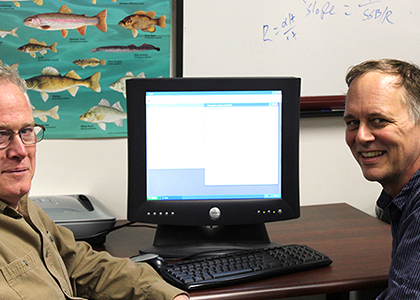Quantitative Fisheries Center

The Institute for Cyber-Enabled Research would like to thank Dr. Norine Dobiesz for contributing the article below to the iCER Research Highlights.
The Quantitative Fisheries Center (QFC) was established at Michigan State University to provide research, education, and consulting services to fishery management agencies in the Great Lakes region. The QFC is co-directed by Drs. Jim Bence and Mike Jones, and currently is supported by an associate director, three post-doctoral researchers/visiting scientists, a computer programmer/researcher, 11 graduate students and two academic support staff.
A major research focus at the QFC is the development of new stock assessment methodologies and performance comparisons of different management policies for achieving high fishery yields while simultaneously ensuring long-term sustainability of harvested populations. We make extensive use of AD Model Builder (ADMB), an open-source software package that supports estimating parameters of nonlinear statistical models in a platform that enables highly configurable model development, numerical stability, and rapid and efficient computation. Although ADMB is optimized for our type of models, we frequently construct large and/or complex models utilizing computer intensive operations, such as random effects, and fitting these models can exceed the capacity of desktop computers. We utilize the HPCC resources to run these larger models that even on a dedicated processor require 24 hours or more to complete. Once constructed, we often evaluate model performance using simulations, and we turn to the HPCC to allow us to simulate the generation and fitting of hundreds or thousands of data sets iterations. Conducting these simulations sequentially on a single processor could easily equate to more than 12 months of computer processing time. By utilizing multiple cores simultaneously, the HPCC allows us to complete these simulations in a matter of a few days.
While not every QFC project requires the vast resources of the HPCC, many of our research projects have benefited from the HPCC. Learn more about the quantitative projects by visiting our website at qfc.fw.msu.edu. Some examples of publications whose analyses benefited from the HPCC are:
List of published Manuscripts that Used the HPCC
Li,y., J.R. Bence, and T.O. Brenden. In press. An evaluation of alternative assessments approaches for intermixing fish populations: a case study with Great Lakes lake whitefish. ICES Journal of Marine Science
Li, Y., J.R. Bence, and T.O. Brenden. In preparation. Sensitivity of fishery management performance to alternative frequencies of stock assessment.
Molton, K.J., T.O. Brenden, and J.R. Bence. 2013. Harvest levels that conserve spawning biomass can provide larger and more stable and sustainable yields in intermixed fisheries. Fisheries Research 147:264-283.
Molton, K.J., T.O. Brenden, and J.R. Bence. 2012. Control rule performance for intermixing lake whitefish populations in teh 1836 Treaty Waters of lakes Huron, Michigan, and Superior: a simulation-based evaluation. Journal of Great Lakes Research 38:686-698.
Vandergoot, C.S., and T.O. Brenden. In preparation. Bias and precision of fishery and demographic estimates from a spatial tag-recovery model when inter-regional movements are treated as fixed.
List of Funded Research Proposals That Used or Will be Using the HPCC
Brenden, T.O., and J.R. Bence. 2012. Harvest policy evaluations for Lake Superior lake trout, Lake Huron lake whitefish, and Lake Erie walleye intermixed fisheries. Funding Source: Great Lakes Fishery Commission, Amount: $134,650.
Brenden, T.O., and J.R. Bence. 2012. Finding appropriate harvest policies for admixed fisheries to ensure long-term sustainability of native Great Lakes fishes. Funding Source: Great Lakes Fishery Trust, Amount: $161,239.
Scribner, K., T. Brenden, J. Bence, and W. Scott. 2012. Joint analysis of genetic and age data to estimate trends in strain-specific recruitment of emerging wild lake trout populations in Lake Huron. Funding Source: Great Lakes Fishery Commission, Amount: $169,890.
Bence, J., S. Winterstein, T. Brenden, S. Mayhew, and D. Etter. 2011. Statistical catch-at-age assessment of Michigan black bear population dynamics. Funding Source: Michigan Department of Natural Resources, Amount: $109,231.
Brenden, T.O., J.R. Bence, and K.T. Scribner. 2009. Simultaneous analysis of genetic and age data to estimate stock contribution for mixed-stock and strain, open-water fisheries in the Great Lakes. Funding Source: Great Lakes Fishery Trust, Amount: $338,424.
